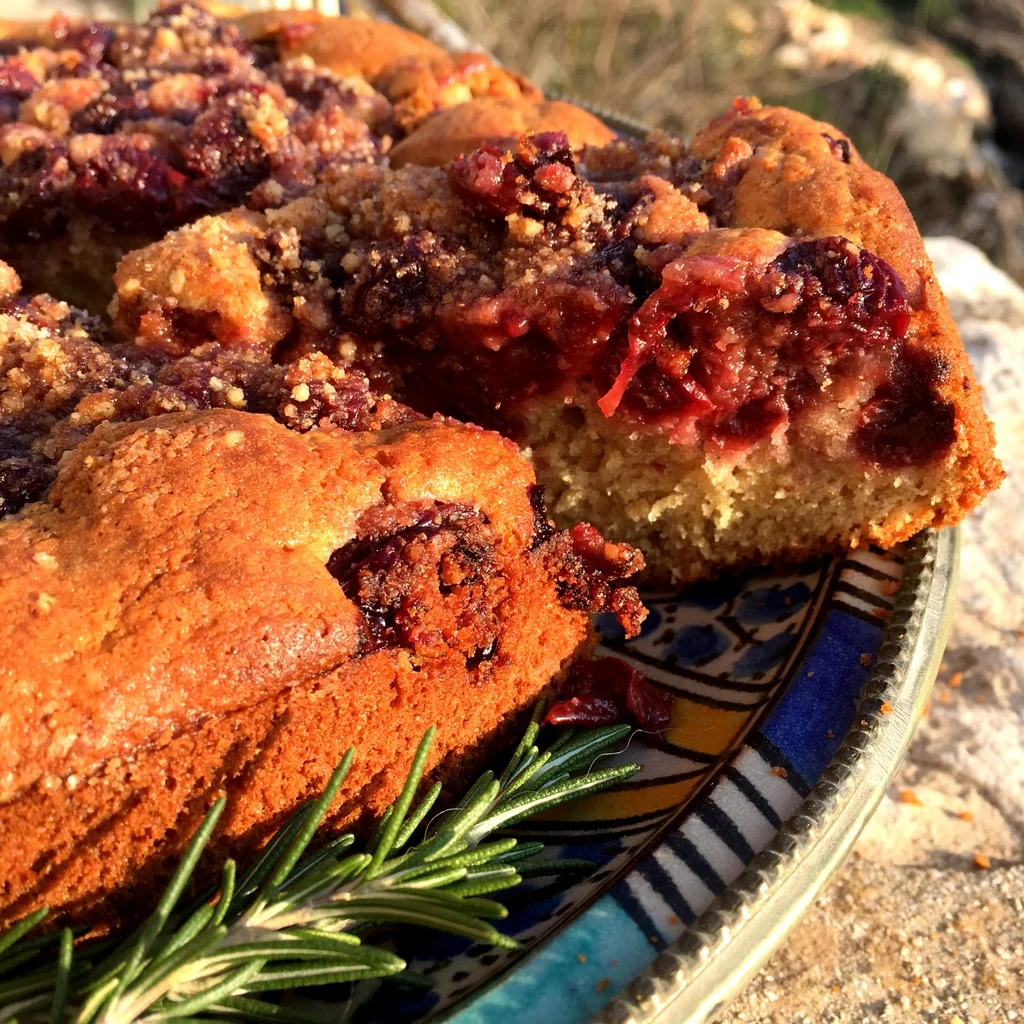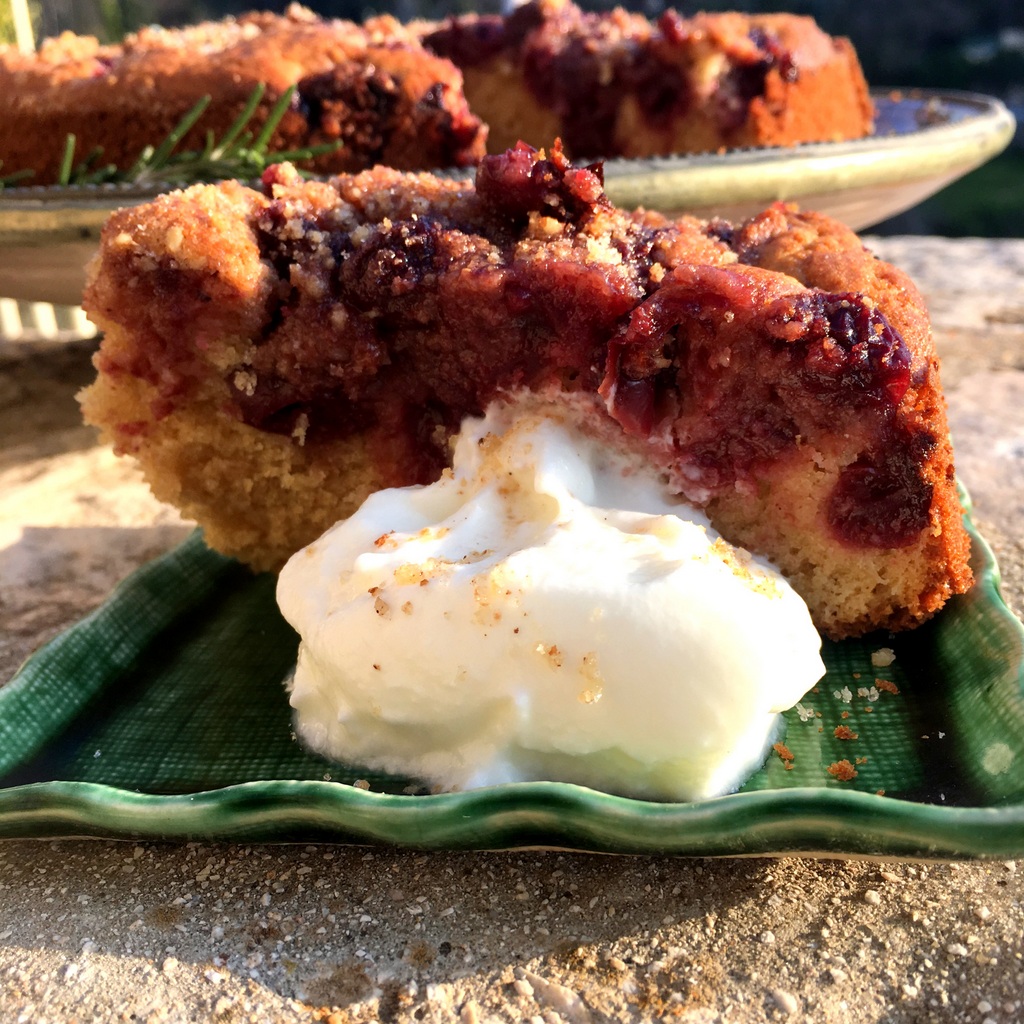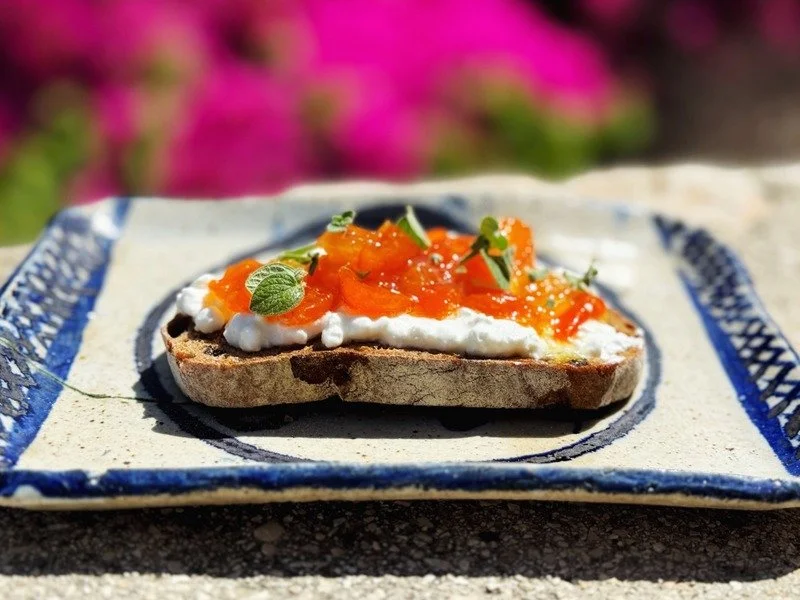One year ago Cauliflower Frittata
Two years ago Chicken Soup with Lemon, Cardamom & Turmeric
It’s spring and a young man’s fancy lightly turns to thoughts of … wait, it’s still only early February!
But you could be fooled, since today was hot in Jerusalem, and although it's strange to say it, it actually feels as if winter is over. Hope I'm wrong and there will still be some rain; but whatever the weather this week's cake is a winner.
It's a butter cake with fruit, a European fruit cake, as opposed to a traditional British one, which is super-easy, quick and really delicious.
NEWS
I’ve been reporting on new controversial Polish legislation to criminalise references to Polish complicity with the Nazis in the murder of Jews during World War Two. This goes beyond their stated – and understandable – concern to have people stop referring to death camps such as Auschwitz, which were located in Poland, as Polish death camps. 150,000 Poles were murdered in Auschwitz, and they believe “Nazi death camps in occupied Poland” is more accurate.
This legislation, championed by Polish nationalists, ramps it up to a new level; now anyone “misrepresenting” the actions of Poland during World War Two faces 3 years prison.
Polish police officer checks a Jewish man's documents, Krakow Ghetto, 1941. (Polish National Archive)
Reporting on this reminded me of the story of 2 Food is Love grandmothers, Celina Widawski and Ruth Scheuer, sisters who survived the War in Poland by "passing" as Christians. They managed due to their mother's resourcefulness, her high-quality false papers and her fluent German language skills.
This is the ID that saved their lives -- the 1943 Kennekart of Ruth and Celina's mother Genia Wald. It's in the name of Jadwiga Kopaniewska, a real woman, one of their neighbours who had passed away.
I’ve re-posted their story because it's so revealing. It shows how the kindness of the few helped them to survive, and the cruelty of many more, friends and strangers worked against them. This included celebrating the murder of Jews, and betraying Genia and her daughters to the Nazis. This was touch and go for them, a crisis they only overcame due to Genia's courage and resourcefulness. And, she would say, also sheer luck.
The post is powerful because it's an eye-witness account by 2 women who experienced the War by living amongst Poles - and survived to tell us about it.
They are in a minority, of course. Before World War 2, Poland had Europe's largest Jewish population -- 3.5 million people. After the War, less than 10 per cent remained alive. The sisters are in an even smaller category. They were children during the War, and are now in their 80s.
It is worth listening to them. You can read their story here.
Genia Wald with her daughters 10 year old Ruth and 15 year old Celina in Lodz, Poland after WW2. A Jewish officer in Russia's Red Army began crying when he saw them, the first living Jews he had encountered as he fought his way across Poland, to defeat the Nazis.
CAKE!
This is a recipe from an old Sydney mate, Vivian Schenker. Vivian’s sister Susie was a great friend when I was in high-school, and I remember elaborate delicious dinners, feasts actually, at their family home. Vivian and Susie’s grandparents were from Vienna, where they were bakers and also generous hosts, an approach to life which they passed down through their family.
This recipe comes from their grandmother, Mitzi Kuhn. Or it might be from her sister-in-law, always referred to by the girls as Great Aunt Edith. Their recipes have tended to get mixed up until it isn’t clear which is which and whose is whose. (I believe that tucked away in my old hand-written cookbook there is another recipe of Great Aunt Edith’s - a Gugelhupf, a butter cake swirled with chocolate, also very good, which Vivian and Susie's mother Emma gave to me once when I was visiting. Aha! Found it!)
cakeS BEARING GIFTS
It’s been lovely to reconnect with Vivian over her grandmother’s recipe. Such connection is one of the main aims of this project.
When my neighbour, Jade Dogon, saw the cake on my balcony, I invited her over to try it. As well as tea and cake, I was making soup, and complaining to Jade about my food processor giving up the ghost. Not that I really have any grounds for complaint, that old warhorse Moulinex has lasted for some 30 years! And it still works!!! But the plastic container is cracked, and spare parts are hard to find, so I will now have to replace it.
But Jade won’t let me buy a new one.
“No, you can have mine! I don’t use it. I prefer to chop. And it was too much cleaning, it made me crazy!” she exclaimed.
Insisting she was serious, Jade ran home to get her meticulously clean Magimix, with 2 bowls, and endless attachments, plus a (Hebrew) recipe book.
I still can't believe it! You can see that Grandma Mitzi’s cake has great powers 😊 Perhaps we should rename it the Good Luck cake?
FAMILY
Marie and Otto Kuhn came from a family of pastry chefs. They had 2 children, Kurt and baby Emma, just one year old when Hitler annexed Austria in 1938. Realising they had to get out, Mitzi and Otto applied for visas everywhere – including Australia where Otto’s brother and sister had migrated earlier in the 1930s.
Mitzi and Otto had one piece of good news. They received visas from British authorities in Palestine – but for only 2 people. That was not enough for the whole family. Could one parent and one child go? Who should it be? While they were struggling with this terrible choice, the Nazis arrested Otto. He was being held in the concentration camp at Dachau when their Australian visas came through. Four visas. If they could get Otto out of Dachau, they could all go.
“The Nazis let Otto out on the condition that they left everything behind and left the country. Unbelievably lucky,” says Vivian.
Mitzi and Otto arrived in Australia in 1939 with 9-year-old Kurt and 2-year-old Emma. That really was just in the nick of time, before the War began in September that year. They joined Otto’s sister and brother, Edith and Ernst, in Sydney. After doing odd jobs to start with, including cleaning houses, they opened one of Sydney’s first Continental cake shops. It was named Marie K, for Oma Mitzi’s full name, Marie, and they ran it it for about 2 decades.
Throughout those years and afterwards, Mitzi and Otto also always cooked and of course baked for family and friends.
“They made dinner every Friday night, where my sister and I stayed over. They also held a big open afternoon tea every Sunday for broader family and friends,” Vivian recalls. “Mitzi died in 1985 and I still miss her almost daily. We were particularly close.”
BLITZ CAKE
Oma Mitzi’s cake is not a traditional fruit cake, with the fruit inside the batter. It’s a butter cake which you load fruit on top of.
And you change the fruit according to the season – fresh apricots and plums in summer, frozen raspberries, stewed apple or pitted sour cherries from a jar – my current fave – in winter. Or you can go off script and mix some chopped dark chocolate and/or nuts or citrus zest through the batter. All the variations work!
I was interested to make this, because most of the cake recipes I know start with creaming butter and sugar, adding eggs, and end with the flour, and this one is the opposite. You rub the butter, four and sugar together to form crumbs, then add liquids. It produces a very European taste -- as you’d expect from a Viennese pastry chef :-)
The other great thing is that it really is simple. 10 minutes prep and it’s in the oven. Hence the name “Blitz” or lightning cake.
All the women in Vivian’s family make this cake. Her nieces have been making it since they were 4 years old. It really is that easy.
Summer version - with apricots
Oma Mitzi’s Butter Cake with Fruit
INGREDIENTS
4 oz / 113 g butter
¾ cup sugar
2 cups self-raising flour
2 eggs
1 cup milk
1 teaspoon vanilla paste
FRUIT – SUMMER
16-20 apricots or plums, stoned and halved.
Flaked almonds
1 teaspoon cinnamon
3 tablespoons sugar to sprinkle on top
FRUIT – WINTER
750 g jar sour cherries, drained
¼ cup breadcrumbs
¼ cup ground almonds or walnuts
4 tablespoons sugar
1 teaspoon cinnamon
grated rind of half a lemon
METHOD
1. Pre-heat oven to 190 C. Line a large tin – say 26 cm - with baking paper. You want it large so that you get less cake and more fruit.
2. For the summer cake, cut fruit in half and remove stones. For the winter cake, if you’re using sour cherries, mix together the breadcrumbs, ground nuts, sugar and cinnamon. Add grated lemon rind. Reserve 2 tablespoons for sprinking at the end; add to the drained cherries. Let sit while you are making the batter.
3. Put butter, sugar and flour in food processor and pulse for a few seconds, till well distributed. Mitzi would have rubbed the mix together with her fingers, of course. Add eggs, milk and vanilla and pulse again till it forms a batter. Don’t over mix.
4. Pour into the lined pan, place halved apricots or plums as close together as you can on the cake. You want as much fruit as you can fit! Sprinkle with cinnamon and sugar, and then generously with flaked almonds.
5. If making the sour cherry version, place the mix on top of the cake. Sprinkle with reserved nut -breadcrumb mix.
6. Bake for an hour, or a bit less depending on size of tin.
7. Serve slightly warm or at room temperature, with yoghurt or whipped cream. I like it plain, but Vivian sometimes adds a little sugar, and 1 teaspoon vanilla paste, to lightly sweeten.
Vivian often makes half the mixture if she only has a couple of guests, as the cake is best fresh.
Winter version, with sour cherries
NOTE ON SUGAR: The original recipe calls for 1 cup sugar. I reduced it to ¾ cup - now a reflex action. This worked very well with the sour cherries. You might even be able to decrease it further, to ½ cup, with sweeter fruit like apricots.
RECIPE BOOK
Vivian’s mother Emma wrote down a lot of Mitzi and Edith’s recipes, and made sure her daughters had copies.
“Susie bakes more of those things than I do. Her lemon and almond cake for Passover and Mitzi’s chocolate cake with ganache are to die for. Sadly, I developed a passion for a lot of the things they baked much later when they weren’t around to make them... things I didn’t like as a child like yeast buns with povidl, or walnuts or poppy seeds, cream cheese pockets, cheese cake,” says Vivian.
That’s another aim of this project – to gather recipes we won’t know we will miss till it’s too late. After years of baking, I have yet to exactly replicate my grandmother’s honeycake. I've accepted that searching for it may be a life-long project.





























